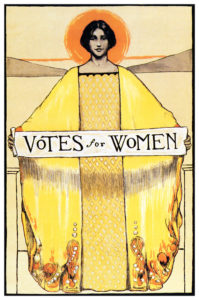American Woman in Politics
CNN is not a station I normally watch except on election nights when MSNBC has a commercial. But I was intrigued when Stephen Colbert had Brooke Baldwin as a guest and she explained the special series she is hosting this fall. I knew there were many women running for office in the midterm elections, but I did not know just how many. Of the 500 who ran, 185 actually won major party primaries for the House; 73% of those are Democrats. At least 31 ran for governor, 54 for Senate, depending on when the count was taken.
I was thinking about our Votes for Women campaign at the Synod. How do we cope with the cognitive dissonance between our country and our church? Not by ignoring it.
Baldwin’s series begins by looking at minority women running, including Stacey Abrams for governor in Georgia: “Working poor but we watched PBS and read books.” Paulette Jordan, a Coeur d’Alene Indian running for governor in Idaho, started her political career on the tribal council at 28. Gina Ortiz Jones’s mother came from the Philippines to Texas; she connected to the church as a child, served in Iraq in the Air Force, and came out as gay as a professional in the Obama administration. She’s running for Congress in San Antonio, where we’re going for Call to Action right after the election. Let’s hope we’re celebrating.

Gun control is the focus of the second video in the series. Christina Hagan in Ohio is for gun rights and Lucy McBath in Georgia wants more gun control. Baldwin finds the commonality in their lives because motherhood is very important to each candidate. McBath lost her son to gun violence. Hagan recognizes that gender bias hurts her in the Republican Party. Both see themselves fighting for their children.
In Alabama, Baldwin places this year’s election in the context of the Doug Jones victory in the 2017 special election – and the Birmingham bombings in 1963. The votes of black women were responsible for the Jones victory, according to most commentators; when they realized their power more than 70 decided to run themselves. Audri Scott Williams is running for Congress even if she has to bring her own chair, as Shirley Chisholm, the first black woman there, said. Cara McClure is going for the Public Service Commission because she used to be a homeless single mom. Jameria Moore shares powerful memories of terror as she runs for probate court judge. All are in Birmingham.
“Next Generation” shifts the focus to the parties’ efforts to develop women candidates, a valuable lesson for us in our movement as well. Again Baldwin dips into history with the many women who ran in 1992, the Year of the Woman that followed the Anita Hill-Clarence Thomas hearings. Emily’s List has changed its focus over the years, and is obviously the big player on the Democratic side. Baldwin explores how the defeat of Hillary Clinton energizes the many potential candidates who come forward to be trained in politics. The Republicans recognize that they are playing catch-up among women; there are new groups and small groups in the fund-raising and candidate-development game. Now the Congress is 20% women; let’s see how it changes after November.
Three generations of women in the Haslem family conclude the series – and urge everyone to VOTE. Grandmother Marian recalls the literacy test and poll tax in 1964; lots of clips of the civil rights movement remind us of how much it cost for blacks to get the right to vote. Now the opportunity to vote for women – and people who look like us – is important to this black family in Birmingham.
Baldwin hosted another American Woman series early this year, and focused on celebrity women “in music, fashion, and film” who “shattered glass ceilings.” I find this fall’s series much more inspiring; I cry at many of these very professional videos. The very act of these candidates’ running makes me hope that enough of them will win to make a difference. They are ordinary women who made a bold decision – to leave themselves vulnerable to criticism, to be a voice for an issue that’s not spoken about enough, to say they deserve power and are going to seek it. Do you see the parallels for those of us who work for women’s ordination?
Is this too far afield from the Synod and the church? I don’t think so. We have talked about the “stained glass ceiling” for years. Since last week we have gathered more than 7,000 signatures for TWO VOTES! Our glacial progress in the institutional church is more like the Republican Party in these videos: slow. But we have a dual strategy. Now women are priests; women take more and more leadership roles; women are not silent – even if we can’t vote.

4 Responses
For the redemption, and the sacramental economy, the masculinity of Jesus is as incidental as the color of his eyes. The Church is “one, holy, catholic, and apostolic,” but not necessarily patriarchal. It is time to dismantle the patriarchal scaffolding that obscures the Catholic faith. After 2000 years of ecclesiastical patriarchy, now we need women priests and women bishops.
“EQUALITY” is a God given Holy Spirit Prophecy for our times. Do not support Sexism, Racism, or any negative inequalities within or without, the Church.
Confirm for yourself.
I’m inspired by this comparison between state and church development of equality for women. I share the hope that in Australia the ordination for women will be given serious consideration by the bishops during their plenary council in 2020. I have put the idea to them with others who share my view.
Thanks for the summary of a tv series I wish I had watched. I hope all these fine candidates win!